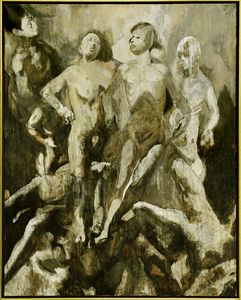WILLIAM UTERMOHLEN (1933))
This Weakness

WILLIAM UTERMOHLEN (1933))
This Weakness
Oil on canvas
H 152.50cm (60.04 in) | W 122.00cm (48.03 in)
| Origin | USA, 1966 |
| Marks | Signed bottom right |
Titled verso: Canto XX1X lines 65-66
Exhibitions
Marlborough Fine Art, London
William Utermohlen 1969 illustrated cat no 20
Galerie d'Eendt, Amsterdam
William Utermohlen 1970 illustrated inside back cover
Literature
The Art of Alzheimer's July 03, 2001
"NEW YORK (Reuters Health) - The initial symptoms of Alzheimer's disease come on slowly, making it hard to look back and know just when an individual's mental decline began. In the case of an artist, though, the course of Alzheimer's disease can be documented in the art itself.
In a case report in the June 30th issue of The Lancet, UK doctors describe one Alzheimer's patient's deteriorating health as seen through his paintings and drawings. Yet while the man's technical skills obviously suffered, his illness did not diminish his creative spirit, they note.
Experts have speculated before that an artist's work can tell volumes about their health at the time. The painter Willem de Kooning, who developed Alzheimer's, is said to have shown signs of the disease in his later, less-coherent work, the authors of the current report note.
Dr. Martin N. Rossor and his colleagues at London's Institute of Neurology report on the case of 66-year-old William Utermohlen, an American artist who moved to England in the 1950s. At the age of 61, he was diagnosed with probable Alzheimer's disease.
To see how the artist's medical condition could have influenced his work, Rossor's team examined paintings and drawings he created from age 60 on. Utermohlen's work at this time centered on self-portraits, and his doctors were able to chart changes in his style that reflect changes in his mental functioning due to Alzheimer's.
For example, a portrait done at age 62 reveals the earliest signs of difficulty in creating individual facial features and spacing them accurately. By age 64, Utermohlen was producing facial features that were "blurred together or strangely disjointed"--changes he and his wife told the doctors were not a shift in artistic style.
At age 65, their patient's work had grown more abstract because the realism of his earlier art was "no longer attainable."
Besides these changes in skill, Rossor's team notes, "the themes of depression or anxiety are apparent particularly in the later self-portraits."
Yet despite these artistic changes, the fact that Utermohlen continued to work suggests Alzheimer's disease spared his artistic drive,this shows that creativity and technical skills may not be equally affected by brain disease, the report indicates.
" This example of continued artistic endeavour at a stage when Alzheimer's disease has blunted the craftsman's most precious tools offers a testament to the resilience of human creativity," Rossor and colleagues conclude".
BBC NEWS - Health Thursday 28 June 2001
A portrait of Alzheimer's
William Utermohlen - showing difficulties in reproducing his perception of his face
"William Utermohlen - showing difficulties in reproducing his perception of his face. An artist's self-portraits, as he battled against Alzheimer's disease, have given doctors a remarkable insight into how the condition affected his brain. Art has been a way for William Utermohlen to express himself since childhood. So it is fitting that, under the eyes of scientists, he has documented the progression of his Alzheimer's disease over recent years through a series of self-portraits. They show how a painter who was noted for his ability to paint detailed figurative work now produces pieces which are far less structured.
A self-portrait painted before the onset of Alzheimer's
A self-portrait painted before the onset of Alzheimer's
Scientists say the portraits show how his perception and spatial awareness has been affected by his condition. And both they and the artist's wife Patricia say the fact Mr Utermohlen continued to produce paintings shows the desire and ability to paint remained despite the effects of dementia. The researchers, from the National Hospital for Neurology and Neurosurgery in London, say this study may shed light on where in creativity is based in the brain. The painter, now 66 was diagnosed five years ago as having Alzheimer's.
Mrs Utermohlen, 73, herself an art historian, told BBC News Online the spatial awareness problems, which affected his art, also had more practical ramifications. "If I say 'pick up a glass of water', he can't really find the glass."
Reproduction
In a paper in The Lancet, the researchers say the self-portraits show how Mr Utermohlen found it increasingly difficult to reproduce the image he saw in the mirror on paper.
A portrait painted last year
A portrait painted last year, showing how Alzheimer's has affected William Utermohlen's art
Simple tests were used to test the disease's effects on drawing abilities to account for the fact that artists can decide to change their style.Images that Mr Utermohlen was asked to paint early in the progress of his condition also showed how he was able to draw features such as arms and legs, although they were inaccurately positioned. He said he knew there was a problem with the image, but not how to remedy it. Mr Utermohlen said he had wanted to show what was happening to him in his art: "Artists see something and they grab it. I grabbed this."
Resilience
Recently he has been unable to paint, after creating art since his childhood, something he says has greatly distressed him.
Patricia Utermohlen believes this portrait shows her husbands fears about his illness
Patricia Utermohlen believes this portrait shows her husbands fears about his illness
His wife points to a self-portrait her husband painted of himself sitting at a table underneath an open skylight, painted before the onset of the disease. She believes painting it shows the fear and isolation he felt about what he already knew was happening to him. She said she believes he had an awareness of what was likely to happen to him when he painted it.
Professor Martin Rosier, who was involved in the research said: "The rapidity and extend of change in the artist's creative ability is indicative of the process above and beyond normal ageing, particularly given his relatively young age at onset." The researchers wrote in The Lancet: "This example of continued artistic endeavour at a stage when Alzheimer's disease has blunted the craftsman's most precious tools offers a testament to the resilience of human creativity."
Ref No 82
Sold
CALL DEALER




